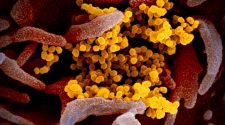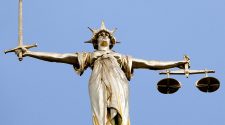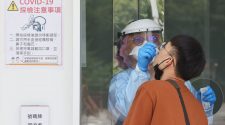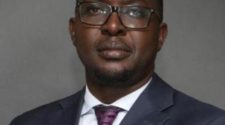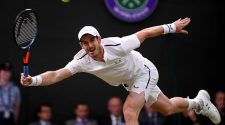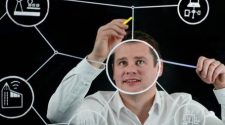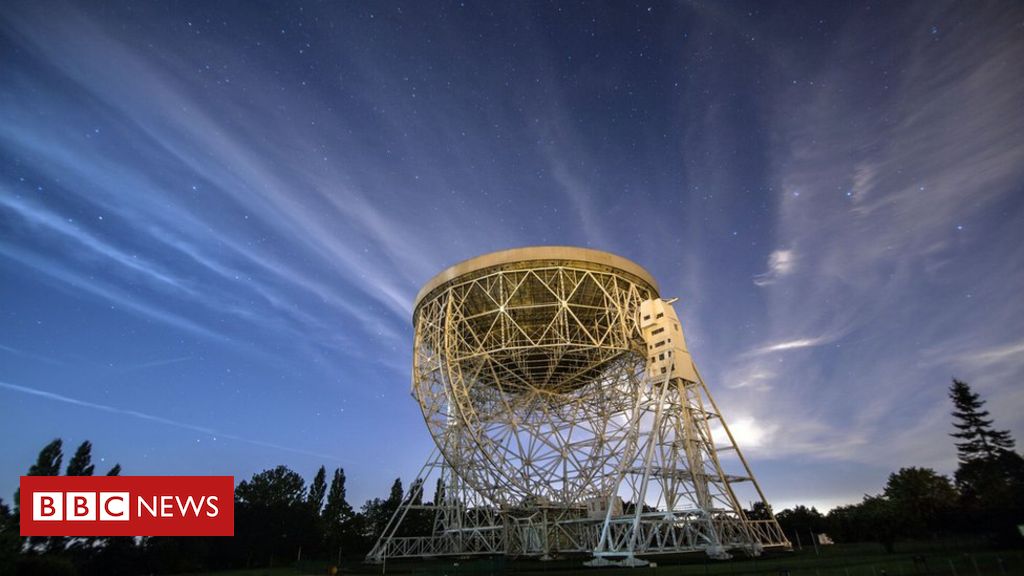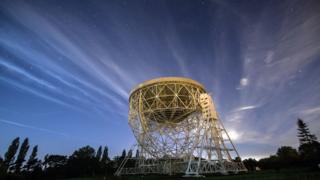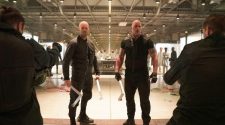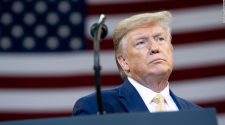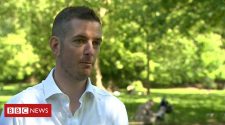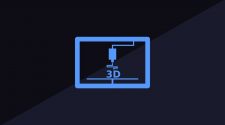The Lovell Telescope played a key role as Apollo 11 prepared to land on the Moon
Fifty years ago, 650 million people around the world sat transfixed to their TV screens as man stepped on the Moon for the first time.
Back on Earth, four scientists at Jodrell Bank Observatory in Cheshire were keeping a close ear on events unfolding on the lunar surface – and with good reason.
The Apollo 11 crew were not alone.
Sir Bernard Lovell and his team were officially tracking an unmanned Russian space probe in orbit around the Moon at the same time.
Image copyright
University of Manchester
Sir Bernard Lovell (centre) and his researchers were among the pioneers of radio astronomy
Bob Pritchard, an engineer at Jodrell who was monitoring transmissions, believed the Russians were making a late dash in the space race.
“I’m sure the intention was to soft land, take a sample of the Moon and get it back to Earth before the Apollo managed to, so they could claim to have done it first and with no risk to human life,” he said.
Luna 15 eventually attempted to land on the Moon’s surface but crash-landed the next day, just two hours before the Americans’ lunar module blasted off on its return to Earth.
Image copyright
NASA
Apollo 11’s crew – Neil Armstrong, Michael Collins and Buzz Aldrin
With the giant Lovell radio telescope also tuning in to communications with Apollo 11, Mr Pritchard said they could hear every word.
“You had the voices of the astronauts as they talked to Ground Control and they re-transmitted the voices of Ground Control talking to the astronauts, so we could hear both sides of the conversation.”
Mr Pritchard said he did not immediately appreciate the significance of what the team had heard.
“I think it finally struck home when one saw the pictures on television of the astronauts returning to Earth,” he said.
“And then you walked out of your house and looked up into the night sky and saw the Moon and said ‘Human beings have walked on that Moon’ and then you think ‘I picked up the signals from them’.”
Jodrell Bank Observatory
Image copyright
Anthony Holloway
The Lovell Telescope was almost not completed as its construction ran over budget
- The site in Cheshire is part of the University of Manchester, dominated by the landmark Lovell Telescope
- The Lovell Telescope was the world’s largest telescope when it was completed in 1957, but is now the third largest
- Jodrell Bank was on standby as the UK’s early warning system against any potential nuclear attack during the 1962 Cuban Missile Crisis
- The Lovell Telescope tracked the first spacecraft to make a soft landing on the Moon in 1966, printing the first picture from the lunar surface
- It is so sensitive that mobile phone use on the site is normally forbidden and the staff microwave oven is shielded by a metal box to prevent interference
- The site featured in BBC’s Stargazing Live series, Douglas Adams’ Hitchhiker’s Guide to the Galaxy and Doctor Who
‘Space nut’
As the scientists were eavesdropping on events in space, a schoolboy was also watching the moon landing just yards away at Jodrell Bank.
Dave Edwards – a self-confessed “space nut” – was nine when his parents took him from Crewe to watch footage of Neil Armstrong take his famous giant leap for mankind.
He remembers it was “exciting and tense but a long affair” and being “very, very tired as the landing was at 4am”.
Image copyright
Dave Edwards
Dave Edwards (right, pictured with his father Bill) holding an Action Man dressed in a spacesuit
As the spacecraft touched down on the lunar surface, Mr Edwards said: “We were all on the edge of our seats.
“We were all worried about the men in the capsule, whether they would be able to land, whether the structure would collapse or something disastrous would go wrong.”
Now 59 and living in Hampton Court, London, he remembers it as an “incredible” experience.
“I can’t imagine anywhere better in England than there to watch it. We got seats close to the front row, too.
“It was one of the best things humans have ever done and it unified everyone.”
Afterwards, his mother Ethel Edwards, now 97, sent him a commemorative postcard stamped with a Jodrell Bank frank which read: “Today we are at Jodrell Bank. Man has just landed on the Moon.”
Image copyright
David Edwards
Ethel Edwards wrote a postcard after watching Neil Armstrong become the first man to set foot on the Moon

